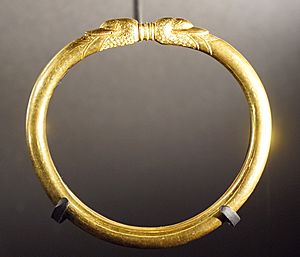Lavau Grave facts for kids
The Lavau Grave is a very important ancient burial site found near the town of Lavau in central France. It's called a "princely burial" because the person buried there was clearly a very powerful and rich leader. This grave dates back to the middle of the 5th century BC, which is about 2,500 years ago!
Archaeologists discovered this amazing grave in 2014. Inside, they found a chariot burial, which means a chariot was buried along with the person. The grave held a man who was over 30 years old. He was buried with incredible gold treasures and special items brought from far away lands. These included a fancy bronze pot from Greece or the Etruscans, and beautiful Greek pottery. Other cool finds were a belt with silver threads, a fancy iron and coral belt buckle, and an amber necklace.
Contents
What Was Found in the Grave?
The Lavau Grave was like a treasure chest from the past. It showed how important the buried person was.
Amazing Gold and Imported Treasures
The most exciting finds were the gold items. These included a gold necklace (called a torc) and gold bracelets. The bronze pot, or cauldron, was very large and decorated. It was likely used for big feasts. The Greek pottery was finely painted and showed art from that time. These items prove that the people in this area traded with distant cultures.
The Chariot and Other Items
Burying a chariot with someone was a sign of great power. It meant the person was a warrior or a very important leader. Besides the chariot, the man had a special belt. It was decorated with silver threads, making it very fancy. His belt buckle was made of iron and bright red coral. An amber necklace was also found, showing connections to northern Europe where amber comes from.
The Burial Site
The grave itself was a huge construction project. It showed how much effort went into burying this important leader.
The Burial Chamber
The man was buried inside a large room built from strong oak wood. This chamber protected his body and the treasures. It was a very special place, showing respect for the person buried there.
The Giant Mound
Over the burial chamber, a huge mound of earth was built. This mound is called a tumulus. It was about 40 meters (130 feet) wide and 6 meters (20 feet) high. Imagine building a hill that big just for one person! This tumulus was the main part of an even bigger burial area. This area had graves from even older times, going back to the Late Bronze Age.
Surrounding Ditches
The entire burial area was surrounded by deep, wide ditches. These ditches were up to 3.5 meters (11 feet) deep and 6-7 meters (20-23 feet) wide. Their corners were carefully lined up with the main compass directions (north, south, east, west). This shows how organized and skilled these ancient people were.
Who Was the 'Prince of Lavau'?
The amazing discoveries at Lavau tell us a lot about the person buried there.
A Powerful Leader
The rich treasures and the grand way he was buried show that this man was very important. Archaeologists call him the 'Prince of Lavau'. He belonged to the highest levels of society. He lived during a time when powerful leaders controlled different areas.
Ancient Cultures
The items found in the grave date from the Hallstatt culture period. This was an important Iron Age culture in Europe. However, some later items suggest the burial itself happened during the early La Tène culture. The La Tène culture followed the Hallstatt culture and is known for its beautiful Celtic art.
A Powerful Leader's Home?
Archaeologists are still looking for where this 'Prince' might have lived.
Finding the 'Princely Seat'
Often, very important burials like this are found near a special home or fortress. This kind of place is sometimes called a 'princely seat'. For the Lavau Prince, no such home has been found nearby yet. Researchers think it might have been on a nearby hill. It's also possible it was located where the city of Troyes is today.
Other Leaders in the Area
Other important burials and strongholds have been found in the area around Lavau. These sites are spread out at regular distances. This suggests that powerful leaders shared control over the land. They might have worked together or divided up the territory.
Gallery
See also
- Vix Grave
- Hochdorf Chieftain's Grave
- Graves of Sainte-Colombe-sur-Seine
- Heuneburg
- Glauberg
- Hohenasperg
- Ipf (mountain)
- Burgstallkogel
- Grafenbühl grave
- Grächwil






